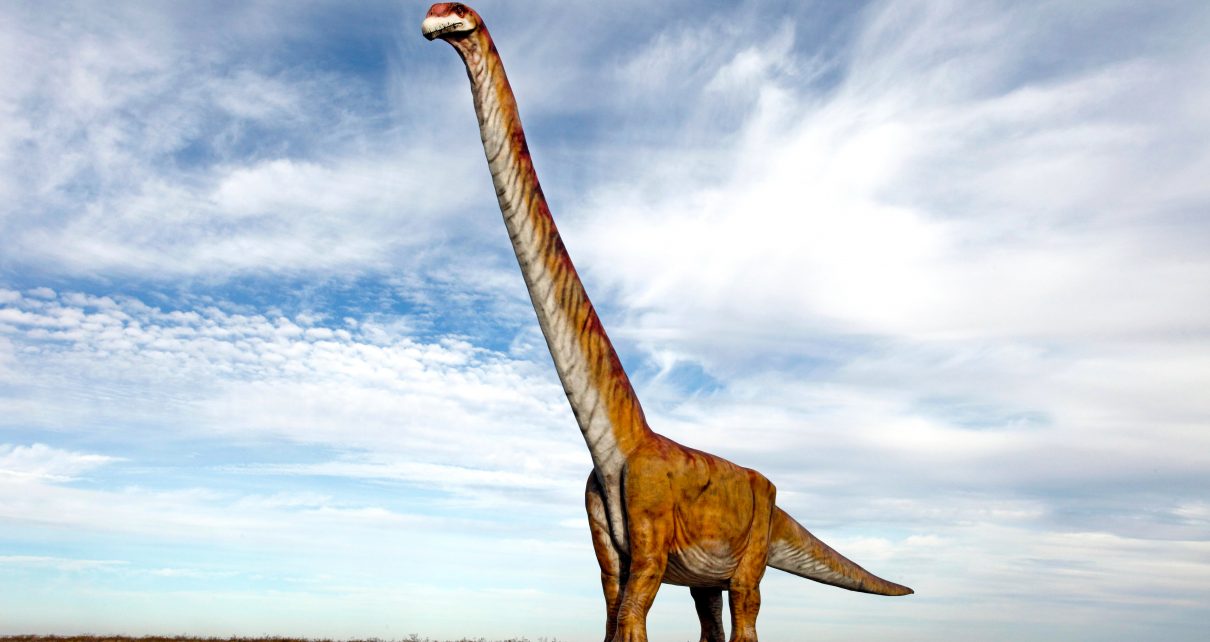On August 9, 2017, paleontologists at the American Museum of Natural History in New York City unveiled the largest animal ever to walk the earth. Dubbed Patagotitan mayorum, the reconstructed skeleton of the 100-million-year-old dinosaur was so huge that it didn’t even fit wholly inside the room in which it stood. The dinosaur’s long neck, bulging body and long tail stretched about 120 feet long, with the living animal estimated to weigh in at more than 70 tons. But now it’s shrunk.
In a new study of the available Patagotitan fossils, representing several individuals of differing ages, paleontologist Alejandro Otero and his colleagues have slimmed down Patagotitan to around 57 tons. The full length of the dinosaur is in question, too, especially as no complete skeleton is known. What was heralded as the largest dinosaur of all in 2014 has wound up in a neck-and-neck tie with several other dinosaurian giants such as Argentinosaurus. The shrinkage comes as part of a long history of supersized dinosaurs that have been downsized after their initial discovery. Incomplete fossils, evolving techniques, and the paleontological preoccupation with enormous dinosaurs have all played into the constant quest to find the biggest creature to walk the planet.
Although many dinosaurs lived large—the famous T. rex was 40 feet long and weighed nine tons—all of the very largest dinosaurs belonged to a group called sauropods. These quadrupedal herbivores are immediately recognizable by their tiny heads, long necks, hefty bodies and tapering tails. Dinosaurs such as Brontosaurus and Diplodocus conveyed the standard image of these plant eaters to museumgoers for more than a century. But even these enormous animals weren’t the largest of all.
“The fact that literally a handful of bones indicates that there truly were terrestrial titans of near mythic proportions leaves us in sheer awe,” says University of Toronto paleontologist Cary Woodruff. Not to mention that these dinosaurs are so strange, from the tip of their snouts to the end of their tapering tails. “With nothing quite like sauropods today,” says Macalester College paleontologist Kristi Curry-Rogers, “our work on these creatures is akin to studying aliens.”
One of the first front-runners was Brachiosaurus, a long-necked herbivore known from a paltry collection of bones uncovered in western Colorado in 1900. Even though only about 20 percent of the skeleton was found, comparisons with similar dinosaurs led to estimates that Brachiosaurus was more than 60 feet long and more than 40 feet tall, a giant that towered over the likes of Apatosaurus and Diplodocus.
But there were larger species out there. The “great-dinosaur renaissance” that lasted from the 1970s through the 1990s saw a new bone rush that uncovered several ever larger dinosaurs. Each was given a name befitting its stature, with “Ultrasaurus,” “Supersaurus,” “Seismosaurus,” and more all making news and documentary appearances as the biggest of the big. Yet the initial announcements from the field didn’t hold up once the fossils were brought back to the lab for study. In fact, some of the supposed giants—such as Ultrasaurus—turned out to be misidentified representatives of other species and not quite so exceptional as originally thought.
And then there are the lost giants. Part of a backbone described by fossil hunter E. D. Cope in the 19th century seemed to suggest a sauropod, known as Amphicoelias, that measured almost twice as long as any other. The problem is that the bone was mysteriously lost, and no other example has turned up over more than a century of fossil expeditions. Likewise a dinosaur from India named Bruhathkayosaurus was rumored to be the largest, but those fossils disintegrated and are no longer available to study.
Even among the giants that paleontologists have in hand, determining the winner is challenging. Part of the problem is that many of the largest dinosaur skeletons are incomplete. “When we imagine how unlikely it is for an entire adult sauropod skeleton to overcome the vagaries of the fossil record, it’s not at all surprising that complete specimens are hard to come by,” Curry-Rogers says. A huge amount of sediment was needed to bury the bodies, which were often ravaged by scavengers before burial. Add different analytic methodologies to the mix, and experts often have to revise their expectations. “Another huge problem, no pun intended, is the issue of exactly what is being measured or estimated,” she says, especially as some longer dinosaurs might be lighter than heavier, shorter dinosaurs, meaning there’s no single metric to determine a winner.
“We all can step on a scale today, but how do we weigh something that cannot be traditionally weighed?” Woodruff says. Paleontologists have tried a variety of methods, from dunking plastic models in water to estimate a dinosaur’s volume to looking at the relation between the circumference of thigh and upper-arm bones to mass. Experts continue to compare and refine techniques, and one study published earlier this year found that different techniques are finding similar results. Over time, estimations of dinosaur size are becoming more refined and falling into accord with each other.
New realizations can change experts’ expectations, too. When paleontologists realized that the vertebrae of sauropods were filled with air sacs to keep them light, she notes, paleontologists had to adjust how they determine mass. “With more knowledge, whether in the form of better living models for comparison or better fossils, comes more precision,” Curry-Rogers says.
But how to determine a winner? Various methods might find a difference of a few tons in sauropod size estimates. That’s a large mass for humans, Woodruff says, but “for an animal already weighing 30 to 40 tons, that’s not a terribly dramatic difference.” Still, those variations will likely only keep fueling the persistent quest to identify the largest animal of all. As Woodruff says, “everyone likes a winner.”



